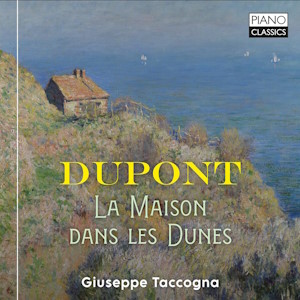
Gabriel Dupont (1878-1914)
La Maison dans les Dunes (1908-9)
Deux airs de ballet (1895)
Feuillets d’album (1897)
Giuseppe Taccogna (piano)
rec. 2024, DIG Area Studios, Molfetta, Italy
Piano Classics PCL10234 [65]
In his review of Bernard Paul-Reynier’s recording, coupled with Les Heures Dolentes, Byzantion lays out the critical landscape for La Maison dans les Dunes, an evocative piano work in ten sections composed in the first decade of the twentieth century under the strong influence of Debussy and, to a lesser extent, Fauré and Ravel.
Dupont, who suffered ill health, and was to die of complications from TB in 1914, composed La Maison dans les Dunes (The House on the Downs) in Cap Ferret at a secluded refuge for TB patients. A product of his temporarily improved health, the ten tableaux are pictorial in inspiration, and the products of an imaginative engagement with land and seascapes. It’s more than a cliché to talk of watercolour analogues but Dupont’s scenes are somewhat like that though they’re capable of artistic smudging, evoking specific scenes: Voiles sur l’eau, for example or Le soleil se joue dans les vagues.
The cycle can take a wide range of interpretation from the relatively brisk to the languorous and extended. Italian pianist Giuseppe Taccogna, born in 1991 and drawn to Liszt and Rachmaninov – a strongly Romantic profile – inclines very much to the School of Languor. That’s not necessarily fatal, especially when the music is richly Fauréan in its lyricism, as it is at points in the third panel, La maison du souvenir, and Taccogna certainly catches the squall and scurry of the rain in the following panel, as well as the withdrawn breadth of Mélancolie du bonheur. However, several panels are very much slower than one normally finds and by No.10 – which stretches to over nine minutes – many performers take this a good two minutes quicker – the cumulative effect can be a touch enervating.
If you prefer a leisurely traversal, Taccogna is cutting-edge at 50 minutes. Marie-Catherine Girod, who has recorded Dupont widely, including his songs, is also measured in her approach on the Mirare label though just a touch quicker than Taccogna. Émile Naoumoff’s Saphir recording is, again, slowish but a little more mobile still. Severin von Eckardstein (on Artalima) conforms rather more to speed imperatives at 44 minutes but if you want Dupont conventionally up-to-tempo Stéphane Lemelin on Atma and François Kerdoncuff on Timpani are your interpreters of choice, as they sacrifice little or nothing in terms of expressive depth whilst taking 41-minutes.
Taccogna adds two other pieces, both written during Dupont’s teens. The Deux airs de ballet, a student work, mines deeply from Fauré in the first whilst the second, with its trills and Aria richness, evokes slightly updated Baroque. Dupont composed Feuillets d’album when he was 19 and the four pieces, though very brief, are sharply etched – there’s youthful ebullience, as well as deft cultivation of fugal procedure, a more characteristic meditative calm in the third panel and a robust dance to end with more than a soupçon of Gallic wit.
The pianist has written his own useful note which is in English only. The studio recording is sympathetic and the production certainly worthy. Whether you are, ultimately, convinced by Taccogna’s loving tempi rather depends on your sense of time in this music.
Jonathan Woolf
Buying this recording via a link below generates revenue for MWI, which helps the site remain free



















